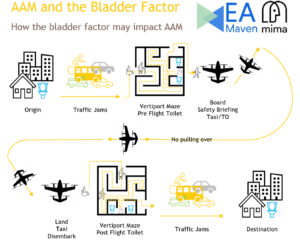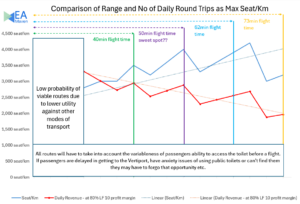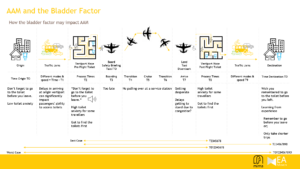In the realm of Advanced Air Mobility (AAM), a fascinating and often overlooked aspect is beginning to gain attention. It’s known colloquially as the ‘bladder factor’, a term that might elicit a chuckle but holds significant importance in the burgeoning industry of electric Vertical Take-Off and Landing (eVTOL) or fixed wing electric aircraft where a toilet is not provided.
This unique collaboration between Electric Aviation Maven, a leader in AAM system planning and forecasting, and Mima, a pioneer in human-centred design, is shedding light on a fundamental question: How long can passengers comfortably go without a restroom during a flight? Below is their white paper on the subject.
The ‘bladder factor’: More Than Just a Comfort Issue
The ‘bladder factor’ transcends the realm of mere convenience, emerging as a critical element in the operational dynamics of UAM and RAM aircraft without toilets. It encompasses the entire journey experience, from the last moment a passenger has an opportunity to use the toilet to boarding the aircraft, the safety briefing, the flight, landing, taxiing to a stand, disembarking and accessing the next toilet.
Industry consensus suggests that sixty minutes is the maximum duration most passengers are comfortable with, though in exceptional circumstances, this can stretch to seventy minutes.

Understanding Human Biological Needs
At the heart of the ‘bladder factor’ lies a basic understanding of human biological needs. On average, people urinate approximately every two and a half hours. However, this frequency can vary significantly, influenced by various medical conditions including pregnancy. While defecation is less of a concern due to its infrequency, it’s important to acknowledge the individual differences in such patterns. Medical conditions like overactive bladder or urinary incontinence, which affect a significant portion of the population, can also necessitate more frequent restroom visits.
Implications for AAM Operations
The ‘bladder factor’ has multifaceted implications for AAM operations. It indirectly influences the maximum range an AAM aircraft without a toilet can cover. The aircraft’s speed and the time it takes to transition between different flight modes are crucial in determining how far it can travel within the comfort window defined by the ‘bladder factor’. This, in turn, impacts the frequency of flights and potential revenue.
Range and Revenue
Longer routes, while potentially more lucrative per ticket, might result in fewer flights per day, affecting daily revenue. Conversely, shorter routes could allow for more frequent flights, leading to higher seat turnover and, potentially, greater revenue. This is however offset by the fact that shorter routes have less utility to travellers as other modes of transport will potentially be more competitive. This dynamic creates a complex balancing act for operators, who must weigh the benefits of longer, less frequent routes against shorter, more frequent ones.
Available Seat Kilometres (ASK)
The ‘bladder factor’ also plays a role in determining the Available Seat Kilometres (ASK), a key metric in aviation that measures capacity and potential revenue. Longer routes, less attractive to passengers concerned about restroom access, might see a limitation in effective ASK. This could lead operators to reconsider their route planning strategies, focusing on optimizing the balance between distance covered and passenger comfort. The following chart is indictive of an eVTOL ASK and Revenue analysis for given ranges and travel times all dependent upon the aircraft operating characteristics. Each aircraft type will have its own ‘curve’ and fixed wing electric aircraft will have one that is elongated by aircraft speed.
Operational Strategies and Passenger Experience
Operational strategies need to be finely tuned to account for the ‘bladder factor’. Flight scheduling, especially during peak hours, should prioritize passenger comfort to enhance loyalty and experience. The speed of the aircraft and the intricacies of its flight modes become critical in this context. The flight experience needs to account for the total time of the operation from boarding, safety briefings and checks, taxiing, take-off, the flight including transitions and the landing sequence including taxi times, disembarking and the time it takes to find a toilet.
Addressing Toilet Anxiety
Toilet anxiety is a real concern for many passengers, and addressing it is crucial in ensuring a positive travel experience. Making restrooms easily locatable in transport hubs can significantly alleviate passenger anxiety. It’s a known fact that between 15 to 35 percent of travellers experience some form of toilet anxiety, ranging from discomfort in using public restrooms to anxiety about being away from them. Clear communication about journey durations and restroom availability at destinations can help passengers plan better, reducing uncertainty and anxiety.
The Human-Centred Approach in AAM
EA Maven and Mima’s collaboration highlights the importance of a human-centred approach in AAM. By focusing on the ‘bladder factor’, they are acknowledging the human element in air travel, which often goes beyond the technical and operational aspects. This approach can lead to innovations in aircraft design, such as more efficient boarding processes or the inclusion of restroom facilities in larger AAM aircraft.
The Future of eVTOL and Urban Air Mobility
As urban air mobility evolves, the role of AAM in transforming cityscapes and transportation networks becomes increasingly significant. The ‘bladder factor’ is just one of many considerations that will shape the future of this industry. It highlights the need for comprehensive planning that takes into account not only the technological capabilities of these aircraft but also the comfort and needs of passengers.
Balancing Efficiency and Comfort
The challenge for AAM aircraft operators and manufacturers is to find the right balance between operational efficiency and passenger comfort. This balance is crucial for the acceptance and success of eVTOL services. As the industry grows, continuous feedback from passengers and ongoing research into human factors will be essential in refining operational strategies and aircraft design.
In summary, the ‘bladder factor’ is a vital consideration in the development and operation of AAM services. It underscores the importance of a passenger-centric approach in the AAM industry, emphasizing the need to balance technical capabilities with human needs. As AAM promise a new era of rapid and efficient air mobility, addressing the ‘bladder factor’ effectively will be key to ensuring their successful integration into our daily lives and transportation systems. Perhaps someday in the future you may hear a friendly reminder on the public address system reminiscent of our younger years when a parent or guardian would say ‘don’t forget to go to the bathroom before we leave.”
Note: Both EA Maven and Mima will be posting additional content on their respective websites www.eamaven.com and www.mimagroup.com as well as posting additional information on their LinkedIn sites and or X accounts.

